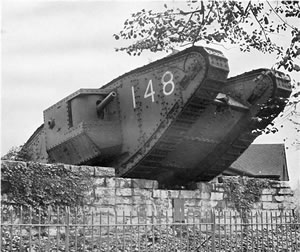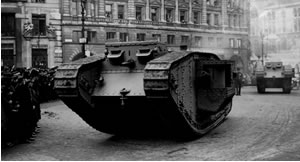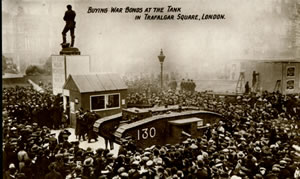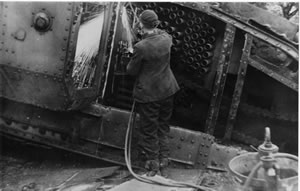Chiswick's Own Tank |
|||||
Historian David Fletcher on the day the mighty machine rolled into town
In November 1917 two mark IV tanks took part in the Lord Mayor’s Show, rolling in at a stately 3mph through the streets of London signalling the start of an auspicious month for the Tank Corps. On November 20th they launched the memorable Battle of Cambrai, the first one ever to be dominated by tanks. It was a temporary success but on an impressive scale and for the first time since the war began church bells rang out across Britain. Public interest in the tanks was high and, in an effort to capitalise on this, a tank named Nelson was included in a display of weapons set up in Trafalgar Square. It was at this point the idea to use tanks to promote sales of War Bonds was conceived. The National War Savings Committee arranged with the War Office for six tanks to tour the country and in March 1918 all six of them concentrated their efforts on London.
A tank visited Chiswick on 14th March having come from Ealing on the previous day and due in Fulham on the 15th. That tank was No.130 otherwise known as Nelson. For a day it proved to be the focal point of events in Chiswick. The usual practice was to park the tank up at some central location and have a pretty girl from one of the local banks sitting in one of gun sponson on the side. She would hand out vouchers to be taken to the bank where the War Bonds could be purchased. According to an item in the Chiswick Times of 22nd March a total of £243,069 was raised, which worked out at £6. 8s per head of population – not bad for 1918. For comparison though West Hartlepool, which came top of the league, raised £31. 0s 1d. per head. In April 1919 the National War Savings Committee published a list of 265 towns in England and Wales which were to receive memorial tanks in recognition of their contribution. The list appeared in their journal, The Silver Bullet, but Chiswick is not on that list. So what happened? We know Chiswick had a tank and we know that it was supplied on behalf of the National War Savings Committee so we can only assume that Chiswick qualified when some town higher up the list refused as some did.
It arrived by train, was unloaded at Grove Park station and driven under its own power to the location selected for it on Turnham Green but there, as far as the reported story goes, the truth ends. According to the report in the press the tank, and the officer commanding it had ‘come over from the front’, but where was the front in 1920? The number 148 is the giveaway. Numbers like this were only painted on training tanks, you won’t ever see them on the fighting tanks in France, so the odds are that number 148 had never been anywhere more dangerous than Bovington Camp in Dorset. The usual drill was for an officer, along with two or three men based at Bovington to select a tank from the huge dump of obsolete machines around the camp and having got it running, load it onto a railway wagon which, in the fullness of time, would arrive at Grove Park station. Here it would be started up and driven, with as much care as possible, to the selected site. Normally there was some sort of official handover with all the civic dignitaries on hand, at which the officer would tell some story of derring do involving the tank, almost always fiction. But in Chiswick it seems this formality was dispensed with. Finally the soldiers climbed into the tank, removed a few vital parts and set off back to Bovington. There is one other slightly curious fact about the Chiswick tank in that it was a male machine. Back in those days you had male and female tanks, identified by their guns. A male tank like 148 has a six pounder (57mm) gun in each side sponson whereas a female has two machine-guns per side in much smaller sponsons. When the scheme to hand out presentation tanks began in 1919 female tanks were preferred. For one thing there were more of them and for another it was felt that a fully operational tank, complete with guns, might be too much of a temptation to the socially disaffected and it was easy to remove the machine-guns from female tanks. Normally, where male tanks were allocated, there was a special reason. A town where tanks had been built or maybe the home of some illustrious person connected with the tanks but by 1920 presumably that threat had diminished for we find quite a few towns and cities receiving male tanks.
Photo by Francis Lewis. The Chiswick tank was chopped up on site in May 1937. They were never really popular being viewed by many not as relics of a victorious war but as ugly reminders if a dreadful struggle. Virtually all of them had gone by the Second World War and the remainder were then cut up for scrap; all but one. If you happen to visit Ashford in Kent they still have theirs; a female machine that only survived because the rear end was once used as an electricity sub-station. If you wish to see a male Mark IV tank like 148 we have one on display here, at the Tank Museum. David Fletcher, with thanks to Mrs Carolyn Hammond for tracking down a lot of information. November 3, 2008 |


 According to the Chiswick Times of Friday 20th February 1920 this tank, carrying the training number 148, arrived in town on ‘the previous Sunday’ (which would have been the 15th).
According to the Chiswick Times of Friday 20th February 1920 this tank, carrying the training number 148, arrived in town on ‘the previous Sunday’ (which would have been the 15th). 